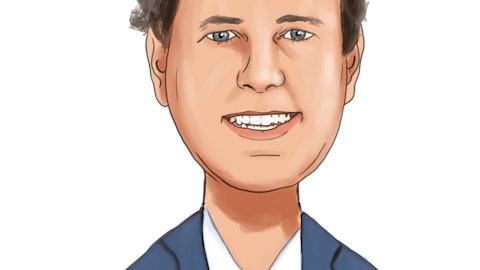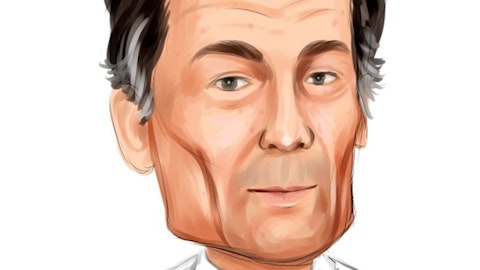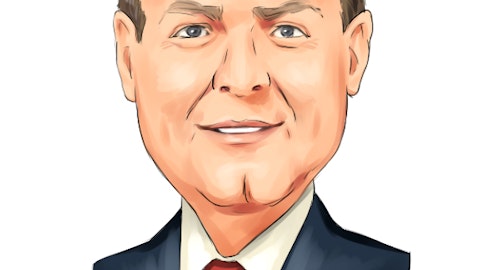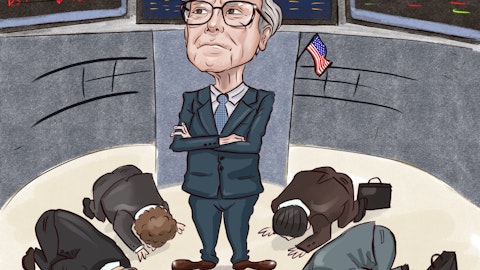Adient plc (NYSE:ADNT) Q1 2023 Earnings Call Transcript February 7, 2023
Operator: Welcome to the Adient First Quarter Fiscal Year 2023 Earnings Call. Today’s conference is being recorded. If have any objections, you may disconnect at this time. I would now like to turn the conference over to your host, Mark Oswald. Thank you.
Mark Oswald: Thank you, Danielle. Good morning, and thank you for joining us as we review Adient’s results for Q1 fiscal 2023. The press release and presentation slides for our call today have been posted to the Investors section of our website at adient.com. This morning, I’m joined by Doug Del Grosso, Adient’s President and Chief Executive Officer; Jerome Dorlack, Executive Vice President and Chief Financial Officer. On today’s call, Doug will provide an update on the business, followed by Jerome, who will review our Q1 financial results and outlook for the remainder of fiscal ’23. After our prepared remarks, we will open the call to your questions. Before I turn the call over to Doug and Jerome, there are a few items I’d like to cover.
First, today’s conference call will include forward-looking statements. These statements are based on the environment as we see it today and therefore, involve risks and uncertainties. I would caution you that our actual results could differ materially from these forward-looking statements made on the call. Please refer to Slide 2 of the presentation for our complete safe harbor statement. In addition to the financial results presented on a GAAP basis, we will be discussing non-GAAP information that we believe is useful in evaluating the company’s operating performance. Reconciliations for these non-GAAP measures to the closest GAAP equivalent can be found in the appendix of our full earnings release. This concludes my comments. I’ll now turn the call over to Doug.
Doug?
Doug Del Grosso: Great. Thanks, Mark. Good morning. Thank you to our investors, prospective investors and analysts joining the call this morning as we review our first quarter results for fiscal 2023. Turning to Slide 4, let me begin with a few comments related to the quarter. As expected, heading into fiscal 2023, the overall operating environment appears to be trending in a positive direction. However, I’d still characterize the environment in Q1 as choppy with certain external influences trending favorably and other influences appearing stubbornly persistent placing downward pressure on the industry. With regard to the positives, it was encouraging to see softening steel, energy and freight costs, FX movements also trended favorably.
While these metrics signaled, we’re moving in the right direction, other challenges such as the resurgence of COVID-19 in China, elevated labor costs, tight labor availability and tightening monetary policies continue to cloud the outlook. Visibility remains murky. That said, unbalance the many puts and takes resulted in a quarter generally in line with our internal expectations. Adding its key financial metrics for the quarter can be seen on the right hand side of the slide. Revenue for the quarter, which totaled $3.7 billion was up $219 million compared to last year’s first quarter. Adjusted EBITDA for the quarter totaled $12 million up $66 million. Adient ended the quarter with a strong cash balance and total liquidity of $900 million and $1.9 billion respectively.
In addition to Q1 fiscal ’23 improved year-on-year financial results, Adient continues to execute actions within its control to position the company for sustained financial success. These actions include but are not limited to the team intense focus on launch execution, cost and operational improvement and customer profitability management. Winning new business across the various regions, customers and platforms which over time are expected to strengthen our leading market position not to mention support improved margins and earnings. The team is also executing actions to provide value add to Adient’s stakeholders every day. Whether that’s our customers, suppliers or employees, these efforts have been validated repeatedly with numerous industry and customer recognition awards including most recently Automotive News Champion of Diversity Award Top Employer 2023 Certification by the top employer institute for Adient EMEA.
And recognition in China from FAW-VW for our quality performance. Finally, adding continues to make progress at building a sustainable future, the details of our many ongoing ESG initiatives as well as our fiscal year 2022 accomplishments are included in the company’s recently published Sustainability Report. Turning to Slide 5 and commenting further on the topic. The 2022 Sustainability Report highlights among other things how Adient is reducing its Scope 1 and Scope 2 absolute greenhouse gas emissions which as shown on the lower right hand side of the slide are down 25% compared with our baseline year for fiscal 2019. Implementing innovative seat solutions, including materials and processes in our metals, plastic, foam, trim and complete seat products that promote a circular economy and helps Adient’s customers meet their ESG goals.
Enforcing policies and practices that protect human rights in accordance with the UN Global Compact, and encouraging our suppliers to adopt similar business practices. And advancing diversity equity and inclusion through employee training opportunities inclusive hiring and employment development processes and employee led business resource groups. In fact, recognizing a diverse and inclusive workforce environment has been part of Adient for years. For more than two decades, the company has been involved in successful diverse joint ventures with Detroit-based Bridgewater Interiors. We are particularly proud that this forward thinking unique joint venture has stood the test of time and continues to grow and remains viable venture for our customers.
One additional milestone to mention during Q1 fiscal year ’23, the science based target initiatives validated Adient’s near term greenhouse gas emissions reduction targets, affirming Adient has established a clear pathway to achieving its emission reduction goals. We realize reaching the company’s full potential cannot be achieved without firmly integrating sustainability into our core Adient’s operation in order to become the foremost sustainable automotive supplier. We’ve included a link to the full report please take a few minutes to see the progress we’ve made in our sustainability journey and the commitments we intended to deliver in the future. Turning to Slides 6 and 7, now let’s take a look at the business wins and launch performance.
As you can see, Slide 6 highlights a few Adient recent wins. Adient continues to successfully navigate the choppy operating environment and related commercial discussions by winning new and replacement business. Programs highlighted represent a good mix of wins across ICE in various levels of EV, powertrains, new entrants and legacy customers, as well as deepening levels of vertical integration including complete seat, foam, trim and metals. One of the programs highlighted is the recently awarded Toyota Rav4 replacement business in China. Also, worth noting NIO’s new Alps vehicle platform was awarded to Adient, strengthening the company’s position with a growing Chinese domestic OEMs. Alps is NIO’s latest sub-brand, marking an entrance into the mass market outside of the premium/luxury space.
One final highlight to mention. As noted in the call-out box to the right, Adient is pleased to provide a complete seat or components to all three 2023 North American Car and Truck of the Year winners Acura Integra, Ford F-150 Lightning and KIA EV6. Looking to Slide 7, as we typically do we’ve highlighted several critical launches that are complete in process or scheduled to begin in the near term. I’m happy to report that launch is currently underway are progressing in line with our expectations. The launches and platform shown not only impact Adient’s just in time facilities but span across our network of foam, trim and metals facilities. The team continues to focus process discipline around launch readiness has driven a very high level of performance, especially considering the launch load and complexity of launches that are planned for the year.
We have no intention of letting up. Before turning the call over to Jerome and turning to Slide 8, let me continue with a few comments related to the current environment and how it’s evolved over the past few months. If you recall entering fiscal year ’23, Adient expected the overall operating environment to improve in ’23 versus ’22. That expectation has not changed based on what’s transpired in our first quarter. That said, certain of the underlying assumptions around variance influences that were expected to have a significant impact in Adient’s 23 results have shifted. As you can see on the slide, we laid out certain positive and negative influence that we navigated entering the year. Many of the positives include — many of the positive influence remain intact such as Adient’s self-help initiatives, the benefits from the balance in, balance out of new programs, the impact of ply chain disruptions, which are still placing downward pressure on the industry, but trending in the right direction.
Commercial settlements with our customers, which encompass a variety of transactional items, including recovery of inflationary costs continue to be successfully negotiated. I would note that as certain inflationary pressures soften, the absolute level of recovery is needed to achieve our ’23 earnings commitment will be reduced, which is good news, think of that as de risking our plan. Lastly, although we continue to forecast a year-on-year tailwind from increased vehicle production, the magnitude of benefits have moderated given the recent revisions to production forecasts. In China, for example, S&P recently lowered the forecast by approximately 500,000 units in the March quarter versus third December forecast. Given Adient’s September 30 fiscal end, the expected recovery, which is largely recalendarized into December quarter, will benefit our fiscal year ’24, not fiscal year ’23.
On the right hand side of the slide, just a few comments that we are seeing and expecting from the three key markets. In the Americas, we continue to monitor potential softening of consumer demand primarily driven by rising interest rates which ultimately impacts affordability. That said, our customers have not signaled through their production forecast to us that this is the case. We believe inventory rebuild combined with the likely increase in sales initiatives should support the current vehicle build assumptions for the remainder of fiscal ’23. In China, we’re monitoring return to work, absenteeism post lunar New Year’s given the potential resurgence of COVID. At this time, absentee remains very low. Most of our facilities now have either low single-digit of cases or no cases at all and we’re managing them as normal absenteeism.
Although vehicle production was revised down in our fiscal second quarter, as I just mentioned, we believe solid economic growth and the absence of COVID restrictions will support improved production beginning in the back half of the year. For Europe, the outlook remains bleak. Lacking positive catalysts for the near-term and long-term in fact, based on S&P forecast vehicle production is not expected to return to pre-COVID levels in the foreseeable future. With that as a backdrop, the team is working on plans to improve the company’s operating and financial performance in the region, assuming production remains at these depressed levels. Actions will be broad-based encompassing our operations above plant costs, future capital spending, et cetera.
I’ll provide additional details as the plan takes shape. Bottom line, we’re focusing on executing our strategy, which we’re confident will drive earnings, margin and cash flow growth in ’23 and beyond. With that, I’ll turn the call over to Jerome. To take us through Adient’s first quarter 2023 financial performance and provide our current thoughts on what to expect as we progress through the remainder of fiscal ’23.
Jerome Dorlack: Thanks, Doug. Let’s jump into the financials on Slide 10. Adhering to our typical format, the pages formatted with our reported results on the left and our adjusted results on the right side. We will focus our commentary on the adjusted results which exclude special items that we view as either one-time in nature or otherwise skew important trends and underlying performance. For the quarter, the biggest drivers of the difference between our reported results and our adjusted results relate to purchasing, accounting, amortization, restructuring and impairment costs and a pension mark-to-market as we settled certain pension plans in the Americas segment and recorded a curtailment settlement loss. Details of the adjustment for the quarter are in the appendix of the presentation.
High level for the quarter sales were approximately $3.7 billion up about 6% compared to our first quarter results last year. Improving vehicle production in the Americas combined with favorable customer mix in China were the primary drivers of the year-over-year increase. Adjusted EBITDA for the quarter was $212 million up $66 million year-on-year. The increase is primarily attributed to the benefits associated with higher volume and mix, improved business performance and commercial recoveries. These benefits were partially offset by the impact of increased business operating costs and the negative impact of currency movements between the two periods. I’ll expand on these key drivers in just a minute. Finally, at the bottom line, Adient reported an adjusted net income of $33 million or $0.34 per share.
Let’s break down the first quarter results in more detail. I’ll cover the next few slides rather quickly as the detail for the results are included on the slides and this should ensure we have adequate amount of time set aside for the Q&A portion of the call. Starting with revenue on Slide 11, we reported consolidated sales of approximately $3.7 billion an increase of $219 million compared with Q1, FY ’22. The primary driver of the year-over-year increase was higher volume and pricing call it $430 million including about $15 million of higher commodity recoveries. The negative impact of FX movement between the two periods impacted the quarter by $211 million focusing on the table on the right hand side of the slide. Adient’s consolidated sales for the Americas and China significantly outpaced production.
Americas’ growth over market was primarily driven by outperformance on key platforms that we’re launching in last year’s first quarter, such as the Nissan Pathfinder, Infiniti QX60 and Toyota Tundra, plus the benefit of increased commercial recoveries. In China, Adient strong customer, mix that supported our growth over market specifically our business with Beijing Benz, GAMC and NIO. In Asia outside of China, the story is similar to the Americas where last year’s volumes were depressed due to program launches and our customer mix was disproportionately impacted by chip shortages. Europe’s modest underperformance was in line with internal expectations, primarily reflecting our decision a few years back to walk away from certain unprofitable business in the region.
With regards to Adient’s unconsolidated seating revenue year-over-year results were down about 9% adjusted for FX. In China where a large majority of Adient’s unconsolidated sales are derived resurgence of COVID had a significant impact to certain of our customers’ production schedules, namely FAW and FCW. Partially offsetting the lower unconsolidated sales in China was improved volume and sales at our unconsolidated – JVs in the Americas and EMEA. Moving to Slide 12, we’ve provided a bridge of adjusted EBITDA to show the performance of our segments between periods. The bucket labeled corporate represents central costs that are not allocated back to the operations such as executive office, communications, corporate finance and legal. Big picture adjusted EBITDA was $212 million in the current quarter versus $146 million reported a year ago.
The primary drivers of the year-on-year comparison are detailed on the page and are consistent with what we expected heading into the quarter. Positive influences included $59 million associated with increased volume and mix. Improved business performance also benefited the quarter by $24 million. Looking deeper within that bucket, the biggest positive driver was improved net material margin of $59 million. In addition, improved launch ops waste and tooling performance provided a $5 million benefit. Partial offsets within business performance were utility and wage inflation, which negatively impacted the quarter by $27 million. Freight was also a headwind, call it $13 million. Outside of business performance, Adient’s SG&A costs were $11 million lower year-on-year.
Primarily driven by the temporary compensation related savings and one-time benefits associated with minor asset sales, specifically certain minor footprint changes. The compensation related savings should not be included in the forward run rate as certain benefits such as the 401(k) match in the Americas were reinstated in January of 2023. Headwinds impacting the year-on-year comparison included higher net commodity prices call it $18 million, the majority of which impacted our EMEA segment. The negative impact of, currency movements between the two periods call it $7 million. Although we expect FX to be a headwind for the quarter and full year, recent currency movements suggest FX will have less of a negative impact on Adient’s 2023 result versus our expectations at the beginning of the fiscal year.

Ollyy/Shutterstock.com
I’ll have additional commentary on what to expect for the remainder of the year in just a few minutes. And finally, given the lower volume and sales at our unconsolidated JVs, and to a lesser extent, Adient’s restructured pricing agreement announced last quarter within our Keiper JV equity income was lower year-over-year by $ 3 million all in all a quarter very much in line with our internal expectations driven from the continued strong execution and performance of our global team. Similar to past quarters, we’ve provided a detailed segment performance slides in the appendix of the presentation. High level, for the Americas, several positive factors drove the year-on-year increase and included improved volume and mix, improved business performance driven by increased net material margin, which was aided by commercial recoveries and to a lesser extent the restructured pricing agreement at our Keiper JV.
Other movements within business performance included the benefits associated with launch, ops waste and tooling performance, not to mention a slight tailwind related to improving operating environment, which resulted and lower inefficiencies versus a year ago. Increased freight was a partial offset to these business performance benefits. Lower SG&A costs primarily driven by compensation-related savings also contributed to the year-on-year improvement. In EMEA, the year-over-year comparison was influenced by several factors such as improved SG&A performance, which included the one-time benefit of minor real estate asset sales, increased equity income resulting from improved volumes at our unconsolidated JVs and a modest improvement from volume and mix.
More than offsetting these benefits were headwinds related to increased commodity costs and lower business performance. Within business performance, utility and wage inflation combined with non — combined with increased non-ocean freight weighed on the quarter. Partial offsets included higher net material margin, aided by commercial recoveries and benefits associated with improved launch ops waste and tooling. In Asia, the benefit of higher volumes and mix that are consolidated entities combined with improved business performance were partially offset by unfavorable FX movements. Equity income was also lower as our unconsolidated JVs were impacted by the broadly reduced volumes in China. Let me now shift to our cash, liquidity and capital structure on Slides 13 and 14.
Starting with cash on slide 13. Adjusted free cash flow defined as operating cash flow, less CapEx was an outflow of $17 million. This compares to an outflow of $74 million last year’s first quarter. The year-on-year improvement and positive outcome was hard fought, especially considering the choppy operating environment and normal seasonality pattern of Adient’s cash flow. The primary drivers of the year-on-year improvement included a higher level of consolidated earnings underpinned by improved volumes and an incrementally improving operating environment, coupled with lower levels of cash interest which was in line with internal expectations given our successful deleveraging efforts. Partial offsets included typical month-to-month working capital movements, the timing and level of commercial settlements and VAT deferrals and payments and planned increases in engineering spend to support our growth in customer launch activity.
One last point is called out on the Slide. Adient continues to utilize factoring programs as a low-cost source of liquidity. At December 31, 2022, we had $181 million of factored receivables versus $218 million at last year’s first quarter end. Flipping to Slide 14. As noted on the right hand of the slide, we ended the quarter with about $1.9 billion in total liquidity, comprised of cash on hand of $901 million and $971 million of undrawn capacity under Adient’s revolving line of credit. Adient’s debt and net debt position totaled about $2.6 billion and $1.7 billion respectively at December 31, 2022. The modest increase in gross debt compared with September 30, 2022, was driven by the recent appreciation of the euro and its direct impact on Adient’s 2024, 3.5% Euro notes.
Speaking of the 3.5% Euro notes, although those notes mature in August of 2024, they become current in August of this year. The team continues to monitor the credit markets and we’ll look to refinance those at an appropriate time obviously driven by market conditions, which have improved in early 2023 compared with late 2022. One last point before moving on and as noted on the slide, Adient continues to forecast free cash generation of about $200 million in FY 2023, underpinned by the Company’s solid operational execution and intense focus on cash management and earnings growth. Given our significant deleveraging over the past few years combined with our expected earnings and cash generation in FY23, Adient remained solidly on track to achieve its target leverage ratio of between 1.5 times to 2 times net debt to adjusted EBITDA.
With that, let’s flip to slide 15 and review our outlook for the remainder of fiscal FY23. As Doug mentioned, the overall operating environment remains choppy with certain external influences trending favorably and other influences appearing stubbornly persistent placing downward pressure on the industry. We are successfully navigating through the various obstacles and continue to expect the operating environment will be much improved in the latter part of 2023 versus the choppy conditions that exist today. That said, the pacing of the improvement is likely to be more back-end weighted versus the gradual improvement we expected when we gave the — our original guidance back in November. Changes to vehicle production schedules predominantly in China, which have been re-calendarized out of the current March quarter is the primary driver.
With that as a backdrop, based on Adient’s first quarter results and current market conditions, including revised production forecast and FX assumptions for the year, we currently forecast the following. Adient’s consolidated sales to land at about $15 billion, up from our prior forecast of $14.7 billion. The increase is primarily driven by revised FX assumptions in particular to the euro which has appreciated from about 1.02 in November when we provided our original guide to around 1.08 today. For adjusted EBITDA, we continue to forecast at approximately $850 million. That said, the composition between consolidated earnings and equity income has been revised. Given the lower level of production forecast at certain of our unconsolidated JVs, equity income is revised down to about $70 million versus the November guide of $90 million.
That said, Adient’s consolidated EBITDA is now forecast to be about $780 million, that would imply an EBITDA margin excluding equity income of about 5.2%, consistent with our earlier guide and a 100 basis point improvement above fiscal 2022. Important to note the re-calendarization of production in China out of the current quarter and its significant impact on equity income and to a lesser extent consolidated results in China given our favorable customer mix, we expect Adient’s Q2 EBITDA to fall short of the 212 Q1 result just announced today, largely driven by the drop in equity income which is forecast at less than $10 million in Q2 versus the $27 million for the quarter just completed. This would now represent the trough in fiscal 2023 earnings.
Moving on, interest expense is still expected at about $160 million given our expected debt and cash balances as well as interest rate expectations, cash taxes, thanks to various tax planning initiatives continues to be forecast at around $90 million. CapEx largely based on customer launch schedules is forecast at $300 million, no change from the November guide. And finally, our improved earnings combined with our reduced calls for cash, such as the benefits associated with our deleveraging and relatively flat cash taxes are expected to underpin free cash generation of about $200 million. Again, no change from November. With that, let’s move on to the Q&A portion of the call. Operator, can we have our first question.
See also 15 Countries that Produce the Most Hydropower and 15 Undervalued Defensive Stocks for 2023.
Q&A Session
Follow Ardent Mines Ltd (PINK:ADNT)
Follow Ardent Mines Ltd (PINK:ADNT)
Operator: Our first question today comes from Rod Lache with Wolfe Research. Your line is now open.
Rod Lache: Good morning, everybody. Just maybe wanted to clarify something. First, your original guidance for 2023 — fiscal ’23 included around $180 million of commodity and other headwinds and you had offset that with $50 million to $70 million of recoveries and little bit over $100 million of performance. It sounds like that $180 million is — that headwind is lower now was hoping you might be able to give us a little bit of color on that. And just more broadly, as some of these headwinds are shifting from commodity to things like labor and energy, can you give us some thoughts on how the recovery discussions may be evolving?
Doug Del Grosso: Yes, maybe I’ll take the second part of it first and then we’ll go back to the specifics. I would say, Rod, when we change what the issues are labor in energy versus material, it is a different conversation with our customers. It’s — let’s say a recovery that they’re not necessarily a custom to discussing because we’ve never had this spike in inflationary pressure in those two areas. And so it’s very different than steel economics, which is part of our dialog even at the inflated levels, we’ve been experiencing in the recent years. That said, I would say the discussions are going well and we’re making good progress and we still have a lot of work to do to get those issues completely resolved. But we were upfront early with our customers.
We went in with a tremendous amount of clarity on the issues and what the customer said. I’d say tend to engage and discuss those issues we’ve made good progress in — but as I said, we still have some work to do and some customers are a little bit more stubborn on the issue.
Jerome Dorlack: Yes. And then to your first question, Rod. In terms of the — what we see in terms of cost that are in the system, I’ll just talk ’22 what we seeing in — sorry ’23. Let’s call it $200 million of costs that are in between net and other sticky costs that are there and bouncing up $100 million of recoveries, I think those recoveries move between whether it’s any kind of recovery or another commercial recovery that we see. I think ocean freight, we see improving, we see energy improving. I think what you have to be careful although is ocean freight we see improving maybe back to ’20 levels but energy costs I think getting back beyond ’22 levels yet. We don’t see it getting back to ’21 levels and we don’t see things like labor improving — labor is there, labor is not going to trend backwards.
And so, to Doug’s point, we need to redouble some of our efforts with those recovery discussions with our customers. And so while maybe Energy softening, there’s other costs that are coming into the system that we need to go back after from that standpoint. So it’s really a basket of goods discussion with the customer. Is that help to answer your questions?
Rod Lache: That is helpful. Maybe just, Jerome, asking it a little bit of a different way, just to help us get a high-level view back in 2022, you had given us some color on like that $675 million of EBITDA reflected it was $400 million of volume, headwind and $100 million is sticky cost and $100 million of temporary costs. It sounds like you’re saying that on the cost side that $200 million is being offset by about $100 million and you still have — you will have another $100 million to go as you look out to 2024. Is that the right way to interpret that?
Jerome Dorlack: Yes, I think that’s a fair way to interpret that.
Rod Lache: Okay. And then just lastly, the conversion on volume and price still a bit under 14% below historical levels, is that — is there anything that’s unusual just relative to launches or anything else? Because I thought that the margins on some of these new launches would be higher just given the complexity that you’re absorbing.
Jerome Dorlack: Yes, I think in an ideal operating environment, I think that’d be correct. But we’re still far from ideal and so we still have a lot of stop-start that’s occurring within our production environment. We’re not running at what I would call optimize the efficiencies because of the stop start nature. I mean, if you look at even China in what would have been our Q1 with the COVID impacts that we saw, especially in the North. And then those trickled down to the south of the country, a lot of stop-start. In Europe, with certain of our customers still a lot of disruption. And then, even in the months of October and November, December was better, but in October and November, we were still kind of in that low ’80s schedule attainment with a lot of our customers. December was a better month. And so still, it’s just not a normal operating environment that would allow us to convert and flow through at 16% to 18% leverage on volume like we have normally.
Doug Del Grosso: I think, on top of that, when you think about it from a mix standpoint and the impact China’s having, that’s a bit of a negative for us. So as that volume improves that contribution margin should improve as well.
Rod Lache: Thank you.
Jerome Dorlack: Thank you. Thanks, Rod.
Operator: Our next question comes from Colin Langan with Wells Fargo. Your line is now open.
Colin Langan: Great. Thanks for taking my questions. Just to follow up on that, I just want to make sure I got the key drivers. You’re holding full-year guidance, but it sounds like sticky costs are up around $20 million, JV incomes down $20 million and that’s offset by $540 million and higher recoveries than you’re expecting. Any other factors we should be thinking about from the change from last quarter?
Jerome Dorlack: No. I mean, I think that’s probably fair from that stand point, Colin. I think the biggest driver is really looking at kind of the equity income piece of it. And what’s happening in China with employee income and the re-calendarization of the volume portion of it is the larger piece of that.
Colin Langan: Okay. And you bring up, China. So one of the surprises I think in the quarter is your Asia margins are actually extremely good. Anything unusual going on in this quarter, that’s not sustained because actually lockdowns in calendar Q4 would have actually kind of messed with the margins in that segment. And yet, they seem to hold on pretty well?
Jerome Dorlack: Yes, no, there were certain one-time commercial settlements in the quarter. And our own internal operations that — will not repeat. And that’s really what drove the margin within the quarter within our China operation.
Doug Del Grosso: That in top of Asia is China and all of our other Asian business, which has not been impacted by COVID. Has not done a year-over-year basis been disrupted like it was a year ago last. We’re on the plus side of launches, roll-in, rollout has been favorable in that albeit on a smaller revenue base. That’s helped to offset some of the China impact.
Colin Langan: Got it. And just lastly, you mentioned in the comments about potential more Europe restructuring actions. Would that be reflected in the current guidance or if you take additional actions and save costs, that would be sort of upside to the outlook?
Jerome Dorlack: Yes, it would be incremental to the current guidance. And so, we’re in the midst of that right now. If you look back two, three years ago, we took on a fairly significant amount of, I think it was some $200 million of restructuring, anticipating a revenue level in the region that’s really not recovered to that level. So as we kind of recalibrate and reset, we’re trying to assess whether there’s additional actions that need to be taken. There’ll be more to come on that if we decide that’s the direction we want to move in.
Colin Langan: Got it. All right, thanks for taking my questions.
Doug Del Grosso: Thank you.
Colin Langan: Welcome.





